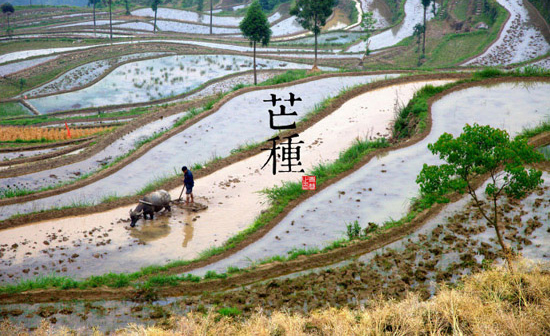The 24 solar terms:part three

Mang Zhong is the busiest season of planting crops such as millet.
Mang Zhong: Grain in Ear
Mang Zhong begins when the sun reaches the celestial longitude of 75 degrees and ends when it reaches the longitude of 90 degrees. More often, it refers in particular to the day when the sun is exactly at the celestial longitude of 75 degrees. It usually begins around June 5 and ends around June 21.
“Mang” refers to crops such as barley and wheat that are becoming ripe. “Zhong” means seeds and rudely implies the busiest season of planting crops such as millet. The arrival of Mang Zhong signifies the ripening of awny crops such as wheat. Mang Zhong is especially critical for planting rice. There is a saying in Guizhou Province that goes, “If you don’t plant rice in Grain in Ear, planting will be in vain.”
The Yangtze River basins induct plum rains when Mang Zhong comes. Plum rains, often occurring during June and July, refer to the long period of continuous rainy or cloudy weather accompanied by frequent and large amounts of rainfall. Due to high temperatures and a lot of rainfall, which leads to high humidity, it is also called mold rains.
During Mang Zhong, as it is near May in lunar calenda, the flowers are withering away, people in old times used to hold ceremony to sacrifice for the “God of Flowers,” showing their gratitude and their eagerness to see the flowers again next year. This custom is already long gone and people can only read the scene in some of the ancient novels. In China’s south Anhui Province, people steam dumplings with new fresh wheat flour after seeding the paddy rice.
Young people of the Dong Minority in Guizhou Province hold mud wrestling matches during Mang Zhong every year. On that day, newly-weds accompanied by their good friends plant rice together. While planting, they throw mud at each other. At the end of this activity, whoever has the most mud on him or her proves that he or she is the most popular person.
Xia Zhi: Summer Solstice
Xia Zhi comes on June 21 to June 22 each year when the sun altitude arrives the highest in the north. This day has the longest day time of the year in the Northern Hemisphere and the sunshine in many cities in southern China may last fourteen hours per day. After this day, the spot of the direct sunlight gradually moves southward and daytime begins to become shorter and shorter in the north. That’s why there is a folk saying which goes, “After eating the Xia Zhi noodles, daytime becomes shorter and shorter.”
In Xia Zhi, due to strong heat absorption by ground and air convection, thunder showers that come and go quickly occur a lot between noon and dusk. A famous poet of the Tang Dynasty (618-907), Liu Yuxi, described this kind of weather in one of his poems “the eastern sky is sunny while the western is rainy; it is thought to be rainy but the sun is still in the sky.”
In some provinces, there is the tradition of eating cold noodles on this day. According to old customs in Beijing, when it comes to Xia Zhi, people can start eating uncooked vegetables and cold noodles to stimulate the appetite and at the same time don’t need to worry about having diarrhea. While in Shandong Province, there is a saying “eating dumplings on the Dong Zhi and eating noodles on the Xia Zhi.”
